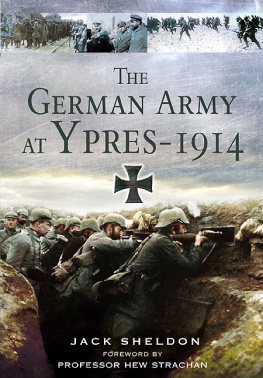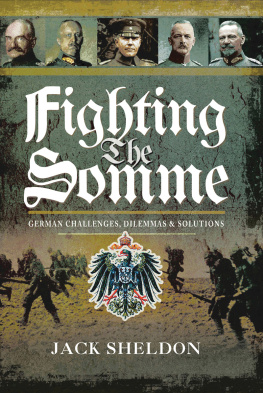To my wife Laurie, who lights up my life.

First published in Great Britain in 2005 by
Pen & Sword Military
an imprint of
Pen & Sword Books Ltd
47 Church Street
Barnsley
South Yorkshire
S70 2AS
Copyright Jack Sheldon, 2005
ISBN: 9781844155132
Digtial Edition ISBN: 9781848847088
The right of Jack Sheldon to be identified as Author of this work has been asserted by him in accordance with the Copyright, Designs and Patents Act 1988.
A CIP catalogue record for this book is available from the British Library
All rights reserved. No part of this book may be reproduced or transmitted in any form or by any means, electronic or mechanical including photocopying, recording or by any information storage and retrieval system, without permission from the Publisher in writing.
Typeset in 10pt Ellington by Pen & Sword Books Limited
Printed and bound in England by CPI UK
Pen & Sword Books Ltd incorporates the imprints of
Pen & Sword Aviation, Pen & Sword Maritime, Pen & Sword Military,
Wharncliffe Local History, Pen & Sword Select,
Pen & Sword Military Classics and Leo Cooper.
For a complete list of Pen & Sword titles please contact
PEN & SWORD BOOKS LIMITED
47 Church Street, Barnsley, South Yorkshire, S70 2AS, England
E-mail:enquiries@pen-and-sword.co.uk website: www.pen-and-sword.co.uk
Contents
Foreword by Professor Richard Holmes
There is no shortage of books on the battle of the Somme: indeed, Martin Middlebrook's seminal The First Day on the Somme and Gary Sheffield's admirable short history The Somme have bracketed my working life, so to speak. But it seems to me that there are two difficulties with even the best books on the battle. First, it was a coalition campaign. Perhaps one-third of the Allied soldiers who fought on the Somme were French, as were 200,000 of the well over 600,000 Allied casualties. And both French and British soldiers fought an enemy who is remarkably badly-documented in English. Of course we all read the section on the German army with which the official historian closes each of his chapters, and we are also all too eager to quote General von Kuhl's deductions about the battle. But the real German army of the Somme, shoved back inch by inch, fighting manfully, across that strip of murdered nature between Albert and Bapaume between July and November 1916, is often reduced to snatches from the German official history or quotes from Ernst Junger.
The chief merit of this much-needed book is that Jack Sheldon has done what all good historians ought, and has gone back to the sources. Although the Prussian archives at Potsdam were badly damaged in the Second World War, the Bavarian archives at Munich survived intact, and there are also many relevant documents in the Wrttemberg archives at Stuttgart. Moreover, although almost all these are accessible only to Germanspeakers, a whole raft of regimental histories had been written long before the Second World War. These documents form the basis for this study, which, in my view, takes us as close as we will ever get to understanding the soldier in field grey who fought my grandfather's generation on the Somme.
Four general points emerge from Jack Sheldon's story. The first is that the Somme had not always been a quiet sector before the first British arrived in the summer of 1915. The French had mounted determined attacks during the battle of Serre in 1915, enabling the Germans to emphasise the importance of deep dug-outs with two entrances, and for at least one corps to distil the lessons of the fighting into an aide mmoire posted in each dugout. The Germans used the period between the arrival of the British and the beginning of the Battle of the Somme to lay out their positions in depth; infantrymen working so hard that, as one divisional commander put it, engineers were only needed in the role of foremen... On 1st July 1916 the British attacked defenders who were expecting their assault (all possible defensive preparations for the attack were made) and were led by officers who had thought hard about how best to break it.
Next, German accounts show just how much British and German performance depended on skilled and determined junior leadership. Thus Reserve Leutnant Vulpius describes setting off on his own with seven British prisoners, realising that he was doomed if a counter-attack came but reflecting that: Luck is one of the greatest soldierly virtues. Hauptmann von Wurmb's decisive action recaptured the Schwaben redoubt on 1st July. The officer who led the successful counter-attack on High Wood in the middle of the same month tells us how he got last-minute intelligence just short of the wood, briefed his men fully about situation and mission, and then took the wood and a hundred prisoners for a relatively light cost in casualties. Conversely, Reserve Leutnant Ballheimer recounts how his counter-attack was mounted with total lack of clarity about the situation and failed: he and his comrades were captured. A regimental commander took the view that once his position was surrounded, German artillery had fallen silent and there seemed no chance of a counterattack he had run out of options: After repeated consultations with my officers I decided to surrender.
Thirdly, although a German lieutenant colonel calls the personal behaviour of British officers beyond all praise, they were often seen as badly-trained: it is noticeable that the British officer lacks thorough, detailed training: he appears to be more of a sportsman. Indeed, many Germans concluded that there were serious errors in the way the British actually fought the battle. One gunner officer thought that the British advanced in hordes on 1 July, and on 18 August; a medical officer saw British infantry suffer severely because they believed that shelling had extinguished all traces of life and attacked hidden machine guns. There were times when the British seemed unable to orchestrate the battle. A captured Australian captain complained that when his division attacked on 29th July the higher command and control must have been extremely poor because there was no way of controlling friendly artillery fire.
And lastly, these accounts emphasise that towards the end of the battle the fighting became an attritional struggle on a landscape mauled by the power of the gun. A gunner officer described his gun position as a scene of the most terrible devastation a crater field strewn randomly everywhere with charred shell-carrying baskets, torn open cartridges and duds. There were also...shell holes so large that they would have comfortably accommodated a complete gun! A platoon commander describes living under the hail of iron as shellfire lacerated his platoon: Peters dead Josson dead Unteroffizier Krutzfeld wounded Nagel dead. It is small wonder that some men were pushed beyond the levels of human endurance: one officer saw a neighbouring regiment streaming backwards in disorder. The commander has apparently lost control over his men. But others found drink and sleep a great restorative: I swallowed two complete mess tins full of tea and rum in one great draught and fell asleep, records an infantryman.
Historians will probably continue to squabble about who actually won the battle of the Somme as long as they discuss anything. Jack Sheldon observes that the Allies did not succeed in breaking through on the Somme, nor did they destroy the morale of the German army. But he agrees that it was never the same afterwards, and quotes a Bavarian general who acknowledged that: The monster of the modern overwhelming machine of war gobbled up our finest men. But in one sense to talk of victory and defeat is to miss the point. As this book makes so very clear, the Somme was a supreme test of human qualities, and the soldiers on both sides displayed them more abundantly than their political leaders deserved, or those who were not there could ever really recognise. Jack Sheldon has sought to do justice to the Sommekmpfer in field grey, just as I have done my best for Tommy Atkins, who was both his adversary and, in the shared agony of one of history's fiercest battles, also his comrade. And when I read this penetrating and harrowing collection I see how much we have needed it, and for so long.
Next page













